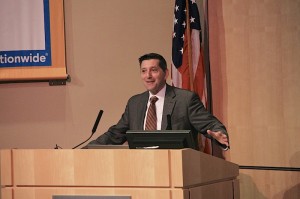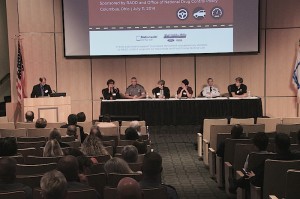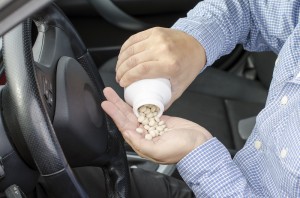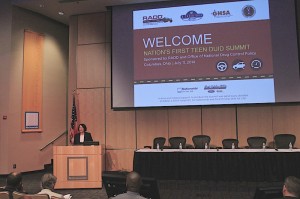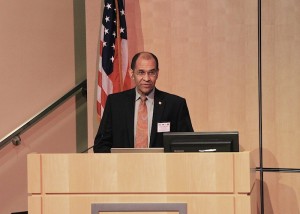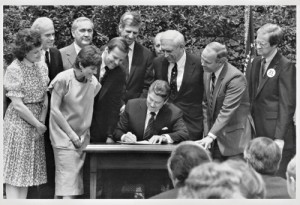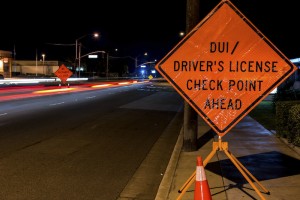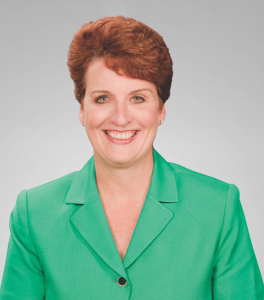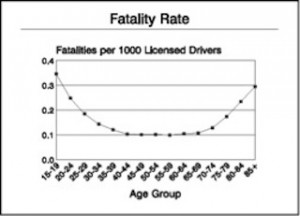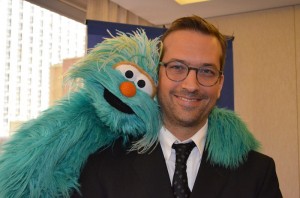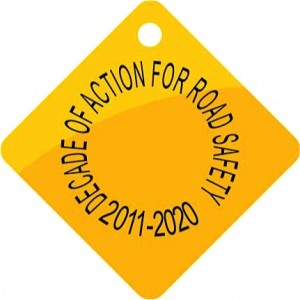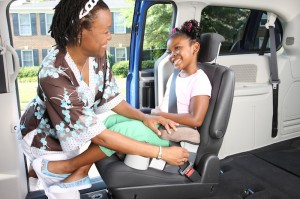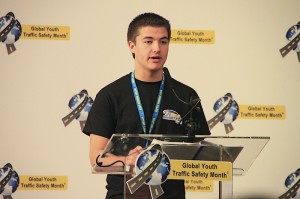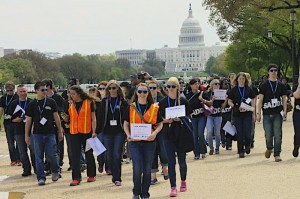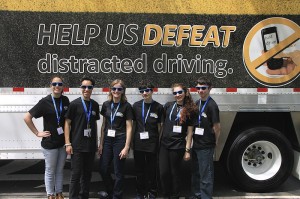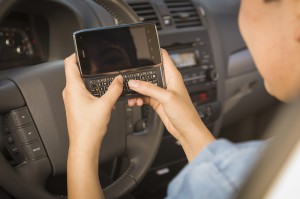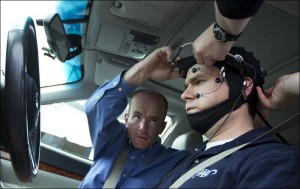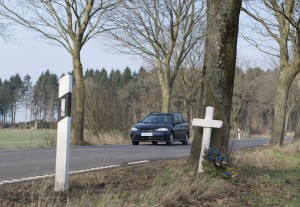27 – Teen Drugged Driving: What You Can Do About It

August 25, 2014 | Posted in Drugged Driving, Podcast Episodes | By Traffic Safety Guy
Comments Off on 27 – Teen Drugged Driving: What You Can Do About It
Podcast: Play in new window | Download
Subscribe: RSS
Did you know that:
- 1 in 8 weekend nighttime drivers tested positive for illicit drugs in 2007?
- 1 in 3 fatally injured drivers who were tested, tested positive for some type of illicit drug in 2010?
- In a national survey of high school seniors, 1 in 8 admitted to using marijuana and then driving in the 2 weeks prior to the survey?
Drugged Driving is a global problem where more people are using some type of drug, whether it is over-the-counter, prescribed, or illicit, and then trying to drive. Many drugs affect our mental and/or physical abilities; that means our driving abilities are impaired if we try to drive after taking the drug. But there are actions we can all take to be aware and proactive in ending this killer.
RADD-ONDCP Teen Drugged Driving Summit
To discuss drugged driving and more specifically teen drugged driving, RADD and the Office of the National Drug Control Policy (ONDCP) co-hosted the nation’s first comprehensive public forum on teen drugged driving. The summit brought together government leaders, scientific experts and community leaders for an in-depth discussion on the latest research and strategies to protect young drivers.
While present at this ground-braking summit, I spoke with a number of the speakers and dignitaries and got their viewpoints on drugged driving and its impact on today’s teens. This episode is a compilation of their comments and an examination of the teen drugged driving issue.
In this episode you will hear from (in alphabetical order):
- Jonathan Adkins, Executive Director, GHSA
- Michael Botticelli, Acting Director, ONDCP
- Jason Demeter, National Student Leadership Council, SADD
- Dr. James Lange, Research Director, RADD
- Erin Meluso, President, RADD
- Sgt. Wesley Stought, Ohio DRE Coordinator, OSHP
- Penny Wells, President & CEO, SADD
- Michael Witter, Region 5 Administrator, NHSTA
Based on our conversations, we examine three questions:
- Is teen drugged driving a problem?
- What do we mean when we say “drugged driving?”
- What do we do about it?
Is Teen Drugged Driving A Problem?
There is no question that drugged driving, and teen drugged driving is a problem. The number and percentage of people who are driving and testing positive for drugs is increasing at a steady rate. A conservative estimate now shows that drugged driving causes 20% of the crashes in the U.S.
Part of the reason for the increasing numbers is the lack of awareness of the issue. MADD and other organizations have done a fantastic job in stigmatizing drinking alcohol and driving, however, the message hasn’t carried over to include other drugs. There is this mistaken belief that by using certain drugs, including marijuana, we are safer drivers. The research proves otherwise. Any drug that impacts our mind, also impacts our driving skills.
What do we mean when we say “Drugged Driving?”
When many people hear the phrase “drugged driving” they automatically think of illegal drugs. However that is only a portion of the drugs causing the burgeoning drugged driving crisis. Drugged driving does occur with the use of illicit drugs, but it can also happen with the use of prescription or over-the-counter medication. Most drugs are designed to affect us, even when used as instructed, such as: reducing pain, stopping an allergic reaction or helping us to fall asleep. It is that effect that can also impair our driving abilities. Labels on medicine bottles commonly have the phrase: “Do not drive or operate heavy machinery while taking the medicine.” A car is heavy machinery. When taking any type of medicine it is important to read the labels and understand how it will affect you.
Drugged driving also includes the use of illicit drugs such as heroin, methamphetamine, and marijuana. The NHTSA Roadside Survey from 2007 found that of the nighttime drivers tested, marijuana was the most commonly detected illicit drug followed by Cocaine and Methamphetamine.
States like Colorado and Washington now allow the use of marijuana and its impact on our highways has grown significantly. This is also true in those states that have “medical marijuana.” In a report entitled: The Legalization of Marijuana in Colorado—The Impact, the percentage of traffic fatalities where the driver tested positive for marijuana doubled from 2007 to 2012. This is in spite of a 14.8% reduction in overall traffic fatalities during the same time.
What can we do about Teen Drugged Driving?
The first response to this question from everyone was the essential requirement of increasing the awareness of drugged driving. We all need to learn more about the issue, understand that drugged driving is occurring everywhere and find out what are some steps we can take to prevent it. Furthermore, going beyond an understanding of the issue, there has to be a self-awareness of any drug use. Too many people do not understand the risks many drugs create; they are taking the drugs and then driving, putting themselves and everyone else on the road in harms way. One useful tool in raising awareness is the ONDCP Teen Drugged Driving: Community Awareness Activity Toolkit. The toolkit provides community groups with the facts on the dangers of teen drugged driving, and activities to assist in its prevention.
Parental involvement was the second answer to the question of ending teen drugged driving. Parents play a pivotal role in educating their teens. As a parent, you can provide good information to your children along with setting clear expectations on what is the expected behavior. As declared by ONDCP Director Botticelli: “Parents are probably the best prevention program that we have.”
Everyone also agreed that to impact teen drugged driving, teens must be at the table, assisting with the development of the message as well as sharing it with other teens. Peer-to-peer messaging is one of the most effective methods of sharing a message; we are more likely to listen to our peers than an outsider who is trying to influence us. This is true for adults as well as teens.
Finally, besides raising awareness, there was the recognition that law enforcement has to be involved in the process. NTSB Acting Chairman Hart noted that it takes legislation, education and enforcement to change behavior. One group of officers actively involved in preventing drugged driving are known as DREs (Drug Recognition Experts). DREs are specially trained officers who recognize the symptoms of someone under the influence of a drug. All 50 states have the DEC (Drug Evaluation & Classification) program as well as a number of other countries and it is showing results. Using a systematic process, DREs examine a driver to determine if a driver is impaired by drug(s) and what category of drug(s) may be causing the impairment. The research demonstrates that the DEC program is reliable and effective.
Conclusion
There is now a wealth of information on the dangers of drugged driving and it is up to all of us to get the facts and share the message. Parents need to step up and learn about the risks and share that information with the family and the community. Teens must start speaking up and let everyone know what is happening and that it must stop.
To end drugged driving requires action by all of us; not just parents, not just teens, not just community leaders, not just law enforcement officers, but everyone. Ending drugged driving will require a comprehensive approach. Yet, when considering the number of lives that will be saved, what could be more important? The time is now, step up, speak out, and save a life.
Additional Information
To watch video recordings of my conversations with these and other dignitaries, check out this webpage on my Traffic Safety Guy website. Finally, I wish to express my gratitude to RADD for arranging the opportunity to speak with everyone. It was a fantastic opportunity.
Related Links:
Websites:
- Ford Driving Skills for Life
- Governor’s Highway Safety Association (GHSA)
- International Drug Evaluation and Classification Program
- National Highway Traffic Safety Administration (NHTSA)
- National Insitute on Drug Abuse
- National Transportation Safety Board (NTSB)
- Office of National Drug Control Policy (ONDCP)
- RADD
- Students Against Destructive Decisions (SADD)
Research:
- Monitoring the Future
- NHTSA 2007 National Roadside Survey of Alcohol and Drug Use by Drivers
- Stop Drugged Driving
Other Resources:
- Highway to Safety Podcast Episode #4 -Drugged Driving: What is it and What Can We Do About It? A Conversation With Dr. Robert DuPont
- Highway to Safety Podcast Episode #13 – Driving and Marijuana—A Dangerous Combination
- The Legalization of Marijuana in Colorado—The Impact
- ONDCP Teen Drugged Driving Community Toolkit
- RADD-ONDCP Teen Drugged Driving Agenda
- RADD-ONDCP Teen Drugged Driving Archived Taped Event
- Traffic Safety Guy – RADD-ONDCP Teen Drugged Driving Summit
ONDCP Acting Director Botticelli discusses Teen Drugged Driving
RADD President Erin Meluso discusses Teen Drugged Driving
26 – Underage Drinking Laws: Saving Lives in Our Communities

August 5, 2014 | Posted in Podcast Episodes, Underage Drinking | By Traffic Safety Guy
Comments Off on 26 – Underage Drinking Laws: Saving Lives in Our Communities
Podcast: Play in new window | Download
Subscribe: RSS
Thirty years ago President Reagan signed the National Minimum Drinking Age Act (NMDAA) that required states to make 21 as the minimum age for purchasing or public possessing alcohol. As a result all 50 states now have 21 as the minimum drinking age. Occasionally, there are efforts made to reduce the drinking age to 18, arguing that teens and college students are still drinking, thus the law is a failure.
The NMDAA Saving Lives on our Highways
This episode and the previous one are examining the National Minimum Drinking Age Act. Part one (Episode 25) examined the law’s purpose and asked if has it been successful in achieving that goal. Part two considers if the law has had any additional benefits and what can be done about underage drinking. To answer that question I speak with Dr. Ralph Hingson, Director of the Epidemiology and Prevention Research at the National Institute on Alcohol Abuse and Alcoholism (NIAAA).
The NMDAA was initially passed to save lives on our roads and highways, and it has been extremely successful in that effort. It is estimated that almost 30,000 lives have been saved because of the requirement to be 21 years old to drink alcohol. Dr. Hingson notes that the estimate of lives saved is most likely very conservative.
Since the early 1980s, there has been a 77% decline in drunk driving deaths for drivers ages 16 to 20. No other age group has had a greater improvement. Dr. Hingson declared that the NMDAA is a “success story of major consequence.”
It has also had a positive impact in matters other than traffic safety. Underage drinking is associated with a variety of significant problems, including: homicides, suicides, risky sexual behavior and poor academic performance. By reducing the number of teens drinking alcohol, these problems have also been reduced.
Lowering the Drinking Age is not the Answer
During our discussion, Dr. Hingson examines the reasons given for reducing the underage drinking law and refutes each claim. The first argument made is that the current age requirement drives teens to drink “underground” and leads teens to drink explosive amounts of alcohol. Supposedly, if the drinking age were lower, then teens wouldn’t be looking for hidden places to drink and they would drink responsibly. However, the research demonstrates that those individuals who are ages 21-24 and are legal to drink, are actually consuming greater quantities of alcohol, 10-20 drinks on an occassion. Thus it is the legal drinkers who are drinking the extreme quantities of alcohol, not the teens for who it is illegal.
A second argument raised is that we should follow Europe’s example on drinking age laws and tolerance since European countries supposedly have fewer issues with drinking. But the research says otherwise. European youth drink more alcohol than here in the Untied States, and there is a higher proportion of those who drink to intoxication. Also of concern, when European countries are compared to other regions of the world, Europe has the highest per capita of alcohol consumption, the highest proportion of alcohol dependence and the highest rate of deaths due to alcohol misuse. When looking at all of the measures used to consider this issue, Dr. Hingson stated that Europe is not a model to emulate. In actuality, it is the U.S. that should be considered a role model for other countries when considering an alcohol policy and teens.
The NMDAA Saving Lives in Our Communities
The research on underage drinking demonstrates that the earlier a person starts to drink, the greater the likelihood the person will become alcohol dependent at some point in his or her life. Over 40% of the youth who start drinking at age 14 or younger will become alcohol dependent; versus 10% of those who become dependent when they start drinking at age 21 or later.
It is also noteworthy that after New Zealand reduced its minimum drinking age from 20 to 18, there was a significant increase in alcohol-related crashes among 15-19 year olds. The increase in drinking by those 18-19 years old was followed by an increase by 16-17 years old even though it was still illegal for the younger ages.
Other scientific research discovered after the NMDAA was passed also supports the law’s continuation. Thanks to technological advances involving brain scans, we now know that even at 21 the brain is still developing. There are important changes occurring in brain development during the teenage years. Alcohol retards these changes, and has both short- and long-term effects, including damage to:
- Memories
- Learning capabilities
- Decision–making process, and
- Reasoning ability
Battling Underage Drinking
While there is no question that underage drinking is an issue, the answer is not to lower the age, the answer is a multi-level approach that targets: individuals, families, and schools. It is important to note that web-based interventions have also shown some promise.
Looking at the individual efforts, having health care professionals to provide screening and brief counseling has been found highly effective, including when it is done at college. Dr. Hingson recommends that all college students who use the health care services should be screened and receive brief counseling, and that the health care professionals take a more proactive role when dealing with young people. Many times a doctor or nurse learns that a teen is drinking or smoking – even though it is illegal – and they don’ provide health care advice on these issues. The research indicates that when these professionals take action, there is a recognized benefit.
In considering the family influence, Dr. Hingson pointed out that parents probably have the strongest influence on preventing underage drinking. If parents binge drink, their children are very likely to do so. Parental permission of alcohol use generally leads to greater incidents of alcohol use by their teens, increased binge drinking and higher rates of alcohol problems.
On the flip side, parents who talk with their children, and provide good role models can have a significant impact on whether or not their children drink alcohol before the age of 21. This is true even after leaving home for college.
Tips for Parents
Dr. Hingson provided some important tips for parents and underage drinking.
- You should model behavior that children can (and will) follow. If you drink heavily then your children are more likely to do so. The reverse can be true as well.
- You need to start talking with your children about alcohol and have clear and consistent rules, and start monitoring them as early as possible.
- Consider what you can collectively do at the community level. Don’t oppose the enforcement of underage drinking laws, support the laws, and collectively monitor where your children are and who their friends are and if they are going to parties where alcohol is available.
- You should not provide alcohol to children; it is linked to heavier drinking patterns and greater developmental problems.
Parents should also consider getting involved with the Community Anti-Drug Coalitions of America (CADCA). CADCA has 5,000 community coalitions across the United States that focuses on underage drinking and other drug issues.
This is an issue that is being looked at in other countries as well. Dr. Hingson is a member of the World Health Organization (WHO) Coordinating Council focusing on ways to implement WHO’s global strategy plan to reduce the harmful effects of alcohol. But here in the United States, we know from the research that the National Minimum Drinking Age Act has saved lives on our roads and in our communities. It is a law that works.
Related Links:
Websites:
- Centers for Disease Control
- Community Anti-Drug Coalitions of America (CADCA)
- Foundation for Advancing Alcohol Responsibility
- Mothers Against Drunk Driving (MADD) – Power of Parents
- National Institute on Alcohol Abuse and Alcoholism
- National Institute on Drug Abuse (NIDA) for Teens
- Surgeon General’s Call to Action to Prevent and Reduce Underage Drinking
Research:
- Case Closed: Research Evidence on the Positive Public Health Impact of the Age 21 Minimum Legal Drinking Age
- New Research Findings Since the 2007 Surgeon General’s Call to Action to Prevent and Reduce Underage Drinking, Hingson, R.
- New Zealand – Reducing the Minimum Purchase Age for Alcohol and Traffic Crashes Among 15 to 19 year olds
- NHTSA – Young Drivers 2012
Other Resources:
- Underage Drinking Laws: Saving Lives on Our Roads – Highway to Safety Podcast – Episode 25
- Underage Drinking: A Homegrown Remedy?
25 – Underage Drinking Laws: Saving Lives on Our Highways

August 1, 2014 | Posted in Podcast Episodes, Underage Drinking | By Traffic Safety Guy
Comments Off on 25 – Underage Drinking Laws: Saving Lives on Our Highways
Podcast: Play in new window | Download
Subscribe: RSS
Have the Underage Drinking Laws Made a Difference?
Thirty years ago President Reagan signed the National Minimum Drinking Age Act (NMDAA) that required states to make 21 as the minimum age for purchasing or public possessing alcohol. As a result all 50 states now have 21 as the minimum drinking age. Occasionally, there are efforts made to reduce the drinking age to 18, arguing that teens and college students are still drinking, thus the law is a failure.
This episode and the one following will be a two-part examination of the National Minimum Drinking Age Act. Part one will examine the reason the law was passed and ask if has it been successful in light of that purpose. Part two will consider if the law has had any additional benefits and what can be done about the issue of underage drinking.
In this episode, I will be speaking with three different individuals about the initial reason for the law. The three people are:
- Bill Bronrott, currently the Deputy Administrator for the Federal Motor Carrier Safety Administration (FMCSA), played an important role in the battle against drunk driving and the National Minimum Drinking Age Act.
- Candace Lightner, President of We Save Lives.org was the founder of Mother’s Against Drunk Driving (MADD) and a strong proponent for this law because of the lives it would save on our highways.
- Bill Morrison, a retired officer from Montgomery County Police Department in Maryland. During his career, Bill saw a number of problems caused by underage drinking and developed a plan to combat it.
Drunk Driving: Starting A National Discussion
When looking at the reason for the NMDAA, it is important to remember in the early 1980s the fight against drunk driving was in its infancy. MADD was established in 1980, back at a time when someone being killed by a drunk driver was tragic, but it was just one of “those things.” Candace Lightner’s daughter Cari, was killed by a repeat drunk driver and she was told by police that it was unlikely her daughter’s killer would see any jail time, let alone prison.
It was during this time that the battle to end drunk driving really started. One of the steps taken was by President Reagan to establish a Presidential Commission on Drunk Driving. The Commission’s purpose was to examine the issue of drunk driving and make appropriate recommendations to combat this deadly issue. The Commission issued a final report one year later with a number of recommendations. Passing national legislation to make the drinking age 21 was the Commission’s number one priority. Already being discussed because of “blood borders,” the recommendation by the Commission helped push the issue to the forefront.
In the early 80’s, blood borders were becoming all too common. Mr. Bronrott and Ms. Lightner both describe blood borders as a horrific consequence of teens driving across state borders where the drinking age was lower, become drunk, and then while trying to drive home, crash and die. Teens were literally dying to get their alcohol.
In fact, drunk driving was the number one cause of death for teens at this time. It was time to end these blood borders and save lives. Efforts had been made on a state-by-state level, however, that proved ineffectual; a national push was required.
The National Minimum Drinking Age Act is Passed
However, like any legislation, getting the Commission’s recommendation passed was not a simple thing. There were competing interest on this issue and they were all speaking with senators and congressmen. Ms. Lightner met with them, talking about her daughter’s death and her desire to stop future deaths.
Armed with a map of the United States showing the blood borders and followed by the media, Ms. Lightner meet with a number of legislators, including then Speaker of the House, Tip O’Neil. After sharing her story and why the minimum drinking age act was important, Speaker O’Neil told his legislative aide to: ‘get her what she wants.’
The law was passed within a year of the commission’s recommendations, and it is considered one of the fastest bills to successfully get through Congress.
At the signing President Reagan declared:
This problem is bigger than the individual States. It’s a grave national problem, and it touches all our lives. With the problem so clear-cut and the proven solution at hand, we have no misgiving about this judicious use of Federal power. I’m convinced that it will help persuade State legislators to act in the national interest to save our children’s lives, by raising the drinking age to 21 across the country.
Underage Drinking in Today’s Society
Of course, it is clear that underage drinking still happens. Teens are finding ways to obtain alcohol, some with fake identification, some at underground parties, and even others through their parents, either with a parent’s consent or just by taking the alcohol from the cabinet.
Underage drinking is definitely a problem, and parents can be both part of the problem and part of the solution. Some parents believe that if they let their teen drink at home, then they know the child is safe. It is the belief that if I as a parent did it while a teen, how can I not allow my child to do it. However, we now know more from the science, and things are different in today’s culture when compared to the way it was 20 and 30 years ago.
Officer Morrison noted that today’s teens are driving in their own car to parties where hard alcohol is being served, drinking a significant amount more alcohol and not worrying about others at the party. At underage drinking parties, he routinely saw teens at extreme BAC (Blood Alcohol Content) levels. He also observed an indifference with today’s teens that when someone is drunk, or maybe trying to drive home, or even being sexually assaulted they simply walk on by. It is considered to be inconvenient to respond or help out.
As noted by Officer Morrison, he has seen too many “good kids who made poor decisions” because of alcohol, and he has made too many death notifications where a teen has driven drunk and killed himself.
His strongest message is for the parents. As a parent, you must become more proactive; show you care about your children, but also hold your children responsible. Take the time to ask questions when your teen is going out and then wait up for them to come home and use all of your senses to learn what is happening. You need to remember that your children will try to push the envelope, and it is part of your job to set boundaries and keep your children safe.
One of the Most Effective Traffic Safety Laws on the Books
Efforts to reduce the minimum drinking age occasionally happen. Are there issues with underage drinking? Of course there are, but there exists other ways to address this issue. To learn about additional benefits of the National Minimum Drinking Age Act and discover some of those ways to address underage drinking, check out Part Two of this discussion.
In the meantime, this law has saved tens of thousands of lives on our roads. According to the National Highway Traffic Safety Administration (NHTSA), the minimum drinking age laws have saved 29,292 lives and some consider that number conservative. The National Minimum Drinking Age Act was proposed as a traffic safety bill, and as a traffic safety law, it has lived up to its promise. 30 years later the number of lives saved on our roads is staggering, and it is still happening. Thousands of people are alive today because of this law.
Related Links:
Websites:
Research:
- CDC – Fact Sheet – Underage Drinking
- NHTSA – Traffic Safety Facts 2012 Data – Young Drivers
- NIAAA – Underage Drinking
- NIH Fact Sheets – Underage Drinking
Other Resources:
- National Minimum Drinking Age Act
- Party Patrols Helps Keep Lid on Alcohol
- Preventing and Dispersing Underage Drinking Parties
- President Reagan’s Remarks on Signing NMDAA
- Training Officers to Patrol Teenage Underage Drinking Parties
Bill Bronrott Talks about the Benefits of the NMDAA
24 – Senior Drivers—and All Other Drivers—9 Tips for Safe Summer Driving

July 15, 2014 | Posted in Podcast Episodes, Senior Driving | By Traffic Safety Guy
Comments Off on 24 – Senior Drivers—and All Other Drivers—9 Tips for Safe Summer Driving
Podcast: Play in new window | Download
Subscribe: RSS
Julie Lee, Vice President and National Director of AARP Driver Safety chats with me about nine important summer driving tips; tips that apply to all drivers. Surprising to many, summer is a more dangerous driving time than winter. In the summer months of June through August 2012, there were 18 percent more fatal car crashes than in the winter months of December through February. In part, the reasons include an increase in the number of people traveling for vacations and the nicer weather, and a major surge in road construction.
Young and Senior Drivers—Not the Same
In 2012, there were 5,560 people 65 and older killed and 214,000 injured in motor vehicle traffic crashes. These older people made up 17 percent of all traffic fatalities and 9 percent of all people injured in traffic crashes during the year. Compared to 2011, fatalities among people 65 and older and injured people in this age group increased by 16 percent.
When looking at the vehicle fatality rate by age, there is a noticeable curve, or U shape. For young drivers where the fatality rate is the highest, the cause is a mixture of actions, primarily all related to inexperience and/or risky behavior. But for drivers over 65, inexperience is clearly not the reason. Being an older driver does not mean an inability to drive, but it can mean an increased fragility. Older drivers are more likely to die in crashes that younger people may survive. Being an older driver requires greater awareness and understanding of any limitations because of aging.
Summer Driving Tips
Recognizing the danger of summer driving and the issues surrounding older drivers, AARP has nine important tips for getting to your destination safely. In this episode, Ms. Lee discusses the tips in more detail, but a summary includes:
- Planning ahead.
- Giving yourself extra time and taking regular breaks.
- Being prepared for emergencies.
- Pulling over to the side—the right way.
- Checking your tires to stay safe and save money.
- Using the three-second rule when driving.
- Avoiding distractions.
- Staying Calm.
- Looking out for motorcyclists and bicyclists.
Being a “Smart Driver”
Ms. Lee and I also talk about the recently revised AARP driving course, Smart Driver. Earlier this year, AARP revised its older driver course to reflect the current state of the research. It also incorporated a message of accepting change with a theme of “Things Change.” The two-day course is about recognizing that everything changes: ones physical abilities, the cars driven, the roads used, and the laws applied. It is about understanding these changes and learning what can be done about them. AARP also created an online driver safety program.
Senior Drivers and Safety Concerns
However, even with the refresher course, at some point, it may be necessary to curtail someone’s driving. Because of safety concerns, you may see the need to have a parent or grandparent stop driving. If that is the case, you will find useful information about having that conversation at “We Need to Talk.” This is always a tough subject but it is an important one, when everyone’s safety is at risk.
One of Ms. Lee’s suggestions is to start having this important discussion before it is needed. This is a conversation to do early and frequently to ensure everyone’s perspective is considered, and everyone understands the next steps when it becomes necessary.
Senior Drivers Moving On
For a lot of people, young and old, driving is a demonstration of independence. Being a senior driver does not mean ending that freedom—it means understanding the changes and responding accordingly. Being a senior driver means taking advantage of the tools and information specifically tailored for you. Using the growing body of knowledge can help all of us drive off into the sunset for many years to come.
Related Links
Websites:
- AARP – Driving Resource Center
- Smart Driver Classroom Course
- Smart Driver Online Course
- AARP We Need to Talk
- AARP Carfit
Research:
- Pet Safety and Harnesses – Consumers Reports
- Traffic Safety Facts—Older Population 2011 Data
- Traffic Safety Facts—Older Population 2012 Data
Other Resources:
- Older Drivers—Time to be a Smart Driver? Traffic Safety Guy Blog
- Senior Drivers: To Drive or Not to Drive. Traffic Safety Guy Blog
- Useful Traffic Safety Tools – Pet Harness. Traffic Safety Guy Website
23 – Developing Road Safety Awareness For a Lifetime: Teaching them Young

June 26, 2014 | Posted in Global Road Safety, Podcast Episodes | By Traffic Safety Guy
Comments Off on 23 – Developing Road Safety Awareness For a Lifetime: Teaching them Young
Podcast: Play in new window | Download
Subscribe: RSS
Jorge Baxter is the Regional Director in Latin America for Sesame Workshop.[1] With over 15 years in the education, arts, and media fields and extensive experience in leveraging media and education for social change, Mr. Baxter is now raising awareness and educating young children about the deadly issue of traffic crashes. In this episode Mr. Baxter discusses what Sesame Workshop is doing to make an impact on traffic safety: globally, regionally and locally.
Traffic Safety is a Global Issue
- Road traffic crashes take the lives of nearly 1.3 million people every year, with almost half being pedestrians, cyclists and motorcyclists.
- Between 20-50 million people are injured in crashes.
- Road traffic crashes have become a leading cause of death for our youth.
Because of statistics like that, the United Nations declared 2011-20120 the Decade of Action for Road Safety. With a goal of saving 5 million lives by 2020, governments and non-governmental organizations are taking action to change those numbers. Sesame Workshop is one of those organizations.
Joining forces with FIA Foundation and Road Safety Global Partnership, Sesame Workshop is developing educational and advocacy material that is engaging and captures children’s and even parent’s attention. When looking at the issue of traffic safety, Sesame Workshop noted that road crashes disproportionally effect the youth and believes it can make a difference globally because of its educational experience and established contacts.
Starting at a Young Age
When making a decision to get involved, Sesame Workshop examines if there is a compelling reason, and if the issue is one for early childhood. Clearly in this situation, the answer to both questions is a resounding yes. With a dearth of early childhood material on traffic safety, it provided an excellent opportunity to be engaged in the issue.
Children are not born knowing road safety issues, and early interaction can be important. Sesame Workshop’s forte is focusing on children ages 3 to 7 and those individuals in a child’s “circle of influence.” Children learn about their environment from their interaction with adults, so targeting the parents as well as the children is an important part of the process. Real impact happens when children and adults talk about road safety together. It is also important that parents act as a good role model on safety practices, like looking both ways before crossing the road.
Public Service Announcements with Grover
A lot of the material looks at educating young children on such safety issues as:
- Playing near roads
- Pedestrian safety, and
- Bicycle safety and wearing a helmet
To help share the message, Sesame Workshop convinced a well-known celebrity to be a road safety ambassador: Grover, the Muppet. Grover is someone children know and find attractive; and he is curious and adventurous. In the traffic safety PSAs created with Grover, he uses the universal “Thumbs Up” to indicate he is safe and ready to go.
Developing a Localized Message
In developing the message, it was important to recognize that local issues make a difference. What works for a rural area will not work for an urban area and vice versa. There can even be large differences within a country, thus it is important to create material that can be used in local areas.
Partnering with Inter-American Development Bank, FIA Foundation and the Costa Rican government, Sesame Workshop has developed a pilot project for Costa Rica. Using local experts and international research on what works, a tool kit for teachers was created. The kit allows teachers to provide children road safety messages that compliment their current teaching curriculum and daily activities in their own community.
Part of the kit includes a “Big Book” that can be used in different group settings. The Big Book includes a series of stories on road safety along with a DVD of audiovisual content. It even has animations created by Plaza Sesamo[2] incorporated into the messaging. Teachers are also trained on road safety so they understand the issues and how they might teach it. By having children take the road safety message home to their parents, it also encourages parents to learn about the issue. Some common topics include: crossing the road, what road signs and signals mean and pedestrian safety. In this fashion, the teachers, the children, and the parents are all learning about traffic safety.
The Ultimate Goal
Sesame Workshop focuses on having an impact; getting children motivated, changing behavior and ultimately on this issue, saving lives. This tool kit and the PSA messaging will empower children to respect cars, understand the dangers around roads and likewise engage their parents. This way children also become change agents for the adults. With the parents involved, the messages are spread throughout the family and into the community. Finally, children learning about road safety at a young age will be a lesson that can last for a lifetime.
Related Links
Websites:
- FIA Foundation
- Global Road Safety Partnership
- Inter-American Development Bank
- Kidsafe Victoria Australia
- Plaza Sesamo – Road Safety
- Sesame Street – Elmo Stays Safe
- Sesame Workshop
- Sesame Workshop – Road Safety
Research:
Other:
Road Safety Ambassador Grover
Sesame Workshop has appointed Grover as the Road Safety Ambassador as part of the United Nations Decade of Action on Road Safety.
[1] Sesame Workshop is the nonprofit educational organization behind Sesame Street. Established 40 years ago, its mission is to use media to educate children around the world.
[2] Plaza Sesamo is the Spanish-language adaptation of Sesame Street for Latin America.
22 – Child Safety Seats and Booster Seats: A Parental Obligation in Today’s Society

June 16, 2014 | Posted in Child Safety Seats, Podcast Episodes | By Traffic Safety Guy
Comments Off on 22 – Child Safety Seats and Booster Seats: A Parental Obligation in Today’s Society
Podcast: Play in new window | Download
Subscribe: RSS
Children, infants and older, can be the most vulnerable individuals in a car crash. That is why as a parent or grandparent, child safety seats and booster seats are two of the most important things you can purchase for your car.
Deborah Hersman and Traffic Safety
Former NTSB Chairman Deborah Hersman is passionate about having all young children sitting in properly installed child safety seats and booster seats. Before stepping down from the National Transportation Safety Board (NTSB), she and I had the great opportunity to discuss child safety seats and booster seats.[1]
A leading safety advocate, Ms. Hersman provided guidance for the NTSB and the United States on what can be done to make our roads and highways safer. For her, child safety seats are important because they are designed for those individuals who can’t speak for themselves, our children.
Great Advances
The fantastic news is that in her lifetime we have seen tremendous positive change on attitudes about child safety seats. Ms. Hersman discusses briefly about her childhood and sitting in the back seat, without wearing a seat belt, and how that evolution changed because of expectations on military bases where her father was stationed, and now from her understanding of why it is important for everyone to always wear a seat belt. Because of that knowledge, her children were required to sit in child safety seats and then booster seats.
Finding and Using the Right Safety Seat
When buying a child safety seat, parents have a lot of great choices and that’s important because families have different needs. Whether the child is large or small, has physical issues, or the family has multiple children, there are options available. But with those choices comes responsibility.
As a parent, you need to purchase the right seat and then recognize that your child will grow. Just like buying new shoes for your kids, your child will grow out of the seat. It is important to start with a rear-facing seat because that seat will provide the most protection possible for a newborn or infant, and then keep her or him in that rear-facing seat for as long as possible. Then it is onto a forward facing seat. Each step along the way, making sure that the seat fits properly and provides appropriate protection.
Booster Seats are the Next Phase
Once a child grows out of a child safety seat, a parent’s reasonability doesn’t end. At that point, it is time for a booster seat. Booster seats allow children to use seat belts that are designed for adults. The lap belt of a seats belt is supposed to go across the hipbone and shoulder strap across the sternum. But for young children, without that booster seat, the straps can go across the stomach or the neck, which are areas that can create significant harm if in a crash.
A child should not be using a seat belt until she or he is at the right height. Even though many states use age as a determining factor, it is the child’s height that should be determined before moving to seat belts. A parent should examine the length of the child’s femur and determine if the child can sit with his or her back against the car seat and have her or his knees bend comfortably. If the knees don’t break over the seat easily, then the child will slouch, which defeats the whole purpose of a seat belt. Typically, a child should be 57 inches tall. The issue is that most children don’t get to a sufficient height until around age 11, which is beyond the age most states require for booster seat. This is again, where a parent’s responsibility comes into play; keeping your child safe beyond what the law requires.
Is Your Child Safety Seat Installed Correctly?
Buying the child safety seat or booster seat is not the only obligation for a parent—it is also making sure the seat is installed correctly, and that can be challenging. As Ms. Hersman notes, when installing a child seat for one of her children, she and her husband read and followed the instructions. Afterwards, they were confident the seat was installed correctly. While at the NTSB, she became a certified technician to install child safety seats and after two days at the weeklong training, she went home and took the seat out because she learned it was not installed correctly. Even well meaning parents can get it wrong. For her, it highlighted the necessity of having parents allow an expert to examine a child’s seat and determine if the installation is correct. The best part of any inspection is that the vast majority of them are free.
Always Use Your Child Seat
With knowledge comes responsibility and as Ms. Hersman stated, a child’s safety is non-negotiable. With the child safety seat or booster seat purchased and properly installed, it now becomes incumbent to use it—every ride, every time.
Many of today’s parents were not raised using child safety seats or booster seats. However, society’s knowledge and understanding has advanced. We now understand the importance of these life saving products. Learning that we can do something better and safer requires action by all of us. At times it can just take education, at other times it takes action by law enforcement officers. But either way, as parents and grandparents, you can evolve and change your behavior and act for the benefit of those silent voices, keeping your children as safe as possible whenever in a car.
Related Links
Websites:
- National Highway Traffic Safety Administration (NHTSA) Child Safety Seat Recall Sign Up
- National Transportation Safety Board (NTSB)
- NTSB’s Most Wanted List
- Safe Kids Worldwide–Seat Check Sites
- Safer Cars/Parents Central–Child Safety Seats
Research:
Other:
- Graco Recalls 3.8 Million Child Safety Seats
- Highway to Safety Podcast–Jennifer Huebner Davidson–Child Safety Seats: Are Yours Installed Correctly?
- Highway to Safety Podcast–Kate Carr–Child Safety Seats: Buckle Up–Every Ride, Every Time
- Highway to Safety Podcast Videos of Chairman Hersman
Deborah Hersman speaking at a Child Safety Seat Event
[1] Deborah Hersman is now President and CEO for the National Safety Council (NSC).
21 – Global Youth Traffic Safety Month – Youth Leading the Way

May 5, 2014 | Posted in Podcast Episodes, Teen Driving | By Traffic Safety Guy
Podcast: Play in new window | Download
Subscribe: RSS
May is Global Youth Traffic Safety Month® and this episode is part of a series examining teen driving, and what can be done for teens to be safer drivers.
I start the series off speaking with Carrie Sandstrom and Noah Brooks, two youth leaders in the United States. Carrie is from North Dakota and she was the 2012-2013 National Student of the Year for Students Against Destructive Decisions (SADD). Noah is from Pickford, Michigan, and he is the 2013-2014 National Vice-President of Programs for Family, Career and Community Leaders of America (FCCLA). Both are also involved with the National Organizations for Youth Safety (NOYS).
The importance of the traffic safety cannot be overstated. Every year 1.3 million people are killed on the world’s roads, with road crashes as the #1 cause of death for people ages 10 to 24. Every day 3,000 people die and many more are injured from traffic crashes that arepreventable. Pedestrians, cyclists and motorcyclists account for 50% of all road traffic deaths. It is because of these troubling facts that the United Nations declared 2011-2020 the Decade of Action for Road Safety.
Global Youth Traffic Safety Month
To raise awareness among the youth, May is “Global Youth Traffic Safety Month” (GYTSM). Hosted by NOYS, GYTSM is a month-long campaign designed to engage teens in traffic safety projects in their communities. As stated by Carrie and Noah, the focus is to have youth develop and share the traffic safety message with other youth. Peer-to-peer messaging can be more effective.
On May 1st, NOYS held the U.S. kick off for GYTSM with a rally followed by a Long Short Walk. The Long Short Walk is an initiative of the Zenani Campaign. Nelson Mandela’s great-granddaughter, Zenani Mandela was killed in a traffic crash when she was 13. The Long Short Walk raises awareness of pedestrian safety, with people from around the globe walking and promoting road safety.
Later in the day the youth attended a Teens & Trucks Program and learned about traffic safety around semi-trucks. Created by the Commercial Vehicle Safety Alliance in collaboration with the Arizona Trucking Association, Arizona Department of Public Safety and American Trucking Associations, the Teens & Trucks Training Program was developed to help educate teens about safe driving practices around commercial vehicles. Teens get the opportunity to hear about driving a semi-truck, see the visual limitations a truck driver has in seeing other traffic, and learn how to drive safely near a truck.
Activities During Global Youth Traffic Safety Month
During May and beyond, a number of activities will take place, such as the Foundation for Advancing Alcohol Responsibility’s (FAAR) I Know Everything[1] school assemblies, mock Traffic Crashes, and SADD SPEAKS[2]. Youth organizations such as NOYS, FCCLA, and SADD, and others from around the county and the globe provide youth the tools needed to share a message of traffic safety. Noah stated that “If teens want to make a difference, don’t have an adult come in and speak to schools and the students as they have in the past, they need to do it themselves.” It is more impactful coming from their peers, and the youth are more likely to listen. The tools are available; the youth just have to take action.
It is Just the Beginning
Bringing students to the Washington DC area for the GYTSM Rally was not a conclusion to the traffic safety effort, it was a start. The youth will now go back home and share with others what it takes to be a safer driver. It means these teens becoming a role model for their peers, for their parents and other adults.
Does it make a difference? According to Carrie and Noah, the youth are getting the message. But it can’t stop. Traffic Safety is an ongoing struggle. “Good Traffic safety never goes out of style,” says Carrie. “It is something that is a constant and something that teens should develop a strong habit of when they are young and continue for the rest of their lives.”
Related Links:
Other Websites:
- Decade of Action for Road Safety
- Family, Career and Community Leaders of America (FCCLA)
- Foundation for Advancing Alcohol Responsibility (FAAR)
- Long Short Walk
- National Organizations for Youth Safety (NOYS)
- Students Against Destructive Decisions (SADD)
Related Links:
- Global Youth Traffic Safety Month Material
- I Know Everything
- It Can Wait (Texting and Driving)
- SADD SPEAKS
- Teens & Trucks
[1]IKnowEverything highlights the issues of drinking alcohol underage and then driving as well as distracted driving, and reiterates that parents have the greatest influence on their teen’s driving behaviors.
[2]SADD SPEAKs is an intensive advocacy training program focused on teen traffic safety. 12 students will be chosen to participate for 2014. These students will participate in online training in May and June, then gather for training in Washington, DC, on June 20-22 before the SADD National Conference (June 22-25). SPEAKs delegates will help train conference attendees in advocacy to prepare them for a rally on Capitol Hill and visits to their legislators at the end of the conference.
20 – End Distracted Driving: One Man’s Journey

April 28, 2014 | Posted in Distracted Driving, Podcast Episodes | By Traffic Safety Guy
Podcast: Play in new window | Download
Subscribe: RSS
Joel Feldman is an attorney and counselor in Philadelphia. After his daughter Casey was killed by a distracted driver, Mr. Feldman created EndDD (End Distracted Driving). He now speaks with teens, adults and businesses about distracted driving and what we need to do to end it.
April is Distracted Driving Awareness Month and this episode is Part Four of a four-part series examining distracted driving, and what we need to do to be safer drivers. Mr. Feldman provides some useful suggestions for teens and parents on how to be safer when on the road.
Distracted Driving is more than Cell Phones
The 58 year-old male driver who struck and killed Casey was reaching for his GPS device as Casey was crossing the street at an intersection. His statement: “I didn’t see her.” He had taken his eyes off the road to look for something in his car.
Mr. Feldman points out that the researchdemonstrates that 40% of distracted driving crashes are the result of cell phone use, with the other 60% from other distractions, including: eating, putting on makeup, shaving, and reaching into the back seat. Distracted Driving is the result of the driver doing something else while driving, at the expense of being fully engaged with the primary task of driving. The resulting costs can be fatal.
End Distracted Driving is Born
After sharing his story of his daughter’s tragic death with a state legislature deliberating a bill aimed at increasing pedestrian safety, Mr. Feldman was a short time later asked to speak about distracted driving to schools and teens. He soon realized that a better approach was possible. Children’s Hospital in Philadelphia, developed a presentation for Mr. Feldman and through EndDD, he now visits schools to talks about this deadly topic in a more proactive manner.
When talking with teens, his message is not a lecture; it is a discussion about a societal problem, not just a teen problem. One facet of the program encourages teens to recognize that they can be role models for their parents, siblings, and friends. When talking to parents, there are two possible approaches. One is to tackle it head on and ask: “Do you use a cell phone while driving?” Not surprisingly, some parents hold to the mistaken belief that because they are experienced drivers, their use of a cell phone is not a problem. Mr. Feldman has found that approaching the issue differently with these parents is more effective. He asks parents how important their teens are to them, and then encourages them to act as good role models for their teens.
Mr. Feldman encourages parents to enter into an agreement with their teens, pledging that neither the parents nor the teens will drive distracted, including using a cell phone. He points out that parents are not fulfilling their overall obligation to be good role models for their teens if driving skills are not included in their discussions. It is all about being the driver you want your teen to be.
Speaking Up as a Bystander
We all seem to think we are above-average drivers – which mathematically is not possible. Mr. Feldman asks parents how many think they are above-average and typically 70% or greater raise their hand. When he asks the question in reverse–how many think they are below average drivers—only 3 raised their hands.
One other facet of Mr. Feldman’s presentation addresses bystander intervention, to really consider how a teen can speak up as a passenger, friend, or even to parents. At first Mr. Feldman was hearing teens say, “My parents are doing it, so why can’t I?” However, now he is hearing, “I don’t have to drive like my mom or my dad, and I want to be a good role model for my brother and sister.” More teens are getting the message.
Recommendations for Safety
Mr. Feldman has two pressing recommendations to teens on the subject of distracted driving:
- Think about the independence you get when you have your driver’s license. With your independence, it is vital to make choices that make sense.
- Whether a driver or a passenger in a car, you need to assume responsibility in getting to your destination safely. It is important to speak up when noticing a behavior that could put everyone at risk.
For parents, Mr. Feldman’s primary recommendation is to go home and tell your child how important he or she is to you and enter into an agreement where both the parent and the child agree not to drive distracted. As he states, parents can send a powerful message when the parent declares, “I made a mistake and I want to change that and work with you so we both live long lives.”
Mr. Feldman finishes his presentations with a picture of a pond and its gentle ripple effect, reminding his audience that we each, individually, can make a difference. If each person who hears his presentation changes his or her behavior and then encourages a friend or family member to do the same, these positive transformations will ripple across the school, county, state and beyond.
In a few more days, Driving Distracted Awareness Month will be over for 2014. However, what isn’t over is the discussion and the effort to raise awareness. Don’t let this be the year where you didn’t make a change for the better. Make the pledge, talk to your teen, share this story and save a life. Don’t drive distracted.
What action are you taking to stop driving distracted? Let me know in the comments below.
Just A Few Seconds PSA
Related Links:
Websites:
Research:
Other:
- EndDD Distracted Driving PSA – Parents Role Model
- Traffic Safety Guy Blog: Hands Free is not Risk Free
19 – Distracted Driving—It’s All In Your Mind

April 21, 2014 | Posted in Distracted Driving, Podcast Episodes | By Traffic Safety Guy
Comments Off on 19 – Distracted Driving—It’s All In Your Mind
Podcast: Play in new window | Download
Subscribe: RSS
April is Distracted Driving Awareness Month and this episode is part three of a four-part series examining distracted driving, and what we need to do to be safer drivers.
Recent research of cognitive distractions found a person’s mental focus does impact driving. Russ Martin, Manager of State Relations at AAA discusses the research, what it means and provides tips on how you can be a safer driver.
Cognitive Distractions are Real
Distracted driving comprises one or more aspects: manual, visual, and/or cognitive. A cognitive or mental distraction has been difficult to study because it all happens within the brain.
Hands-free cell phones, Voice-to-Text software are designed to make it easier to be connected with the world around us. Yet, these same helpful technologies put us in danger when we drive.
Partnering with researchers at the University of Utah, AAA found a way to look into our brains and determine that hands-free technologies used in the car dangerously divert our attention from the vital task of driving.
Groundbreaking Research
For the research, participants wore a skullcap with electrodes attached that were wired to a monitor allowing researchers to examine their brain waves and study mental workload. Participant then ‘drove’ in a simulator or a specially equipped car on the road, performing a number of activities that include:
- Changing the radio station
- Using a cell phones, both hand-held and hands-free
- Sending an email with voice-activated technologies, and
- Doing a math problem.
Reaction time and eye movements were captured with cameras and other electronic devices.
In Phase One of the two-phase study, researchers created a rating scale for cognitive distractions using a scale of one to five, with five being the most distracting type of activity. Changing the radio station was determined to be a one, the least cognitively distracting activity. The use of speech-to-text technologies, such as features allowing drivers to respond to text messages or emails, was rated three, indicating a high level of mental distraction. Phase two of the study is taking an in depth look at the voice-activated technologies and examining what can be done to make them safer.
Creating New Risks?
Automakers are designing devices that allow individuals to keep their hands on the steering wheel, and use voice commands to interact with the car. But this is not limited to carmakers. For example, Apple just came out with Apple CarPlay calling it “a safer way to use your iPhone in the car,” and Google has developed Google Glasses. Companies are reducing manual distractions; but increasing cognitive distractions. This does not make it safer.
Cognitive distractions are just as dangerous, if not more dangerous. Once both phases of the study are done, it is hoped automakers and others will take the research into account in their designs.
However, it is important to acknowledge that others also share the responsibility in creating these new risks; and that is all of us. Customers are asking carmakers for these gadgets, the companies oblige us, and then we use them. A high percentage of AAA members (and non-AAA members) believe distracted driving is dangerous, but still they do it. Driving while chatting on a cell phone (hand-held or hands-free) or sending a text message is distracted driving. It’s a “Do as I say, Not as I Do” attitude. As Russ states, we have “heroic” assumptions of our own driving abilities.
Distracted driving kills and it injures. It isn’t selective, choosing only women, or only men. It doesn’t distinguish between the poor and the rich, or the young and the old. It is an all-encompassing killer. Fortunately, there are ways to help protect you from this killer.
What Can You Do?
First and foremost, when you are in the driver’s seat, the most important thing you can do is focus on the driving. Keep in mind:
- When driving, it is not a time to stow away loose items, to dress or to groom.
- Before driving somewhere, make sure your children are secure with their safety belts fastened, and pets are protected with a harness or other safety device.
- If you have a passenger in the car with you while driving, don’t be afraid to ask for help.
- Eating while driving is distracted driving, so the best course is to always stop and eat. But if you’re going to do it, eat smart snacks such as chips or carrots. Don’t eat food that creates a mess or is difficult to eat, like soup or something that requires two hands.
As Russ stated, there is so much that can be done beforehand to square away everything before even pulling away from the curb. Being proactive could save your life and the lives of your passengers.
What are you doing to reduce your distractions?
Related Links:
Websites:
Research:
- AAA Research – Measuring Cognitive Distraction in the Automobile
- Traffic Injury Research Foundation (TIRF) Research – Driver Distraction and Hands Free Texting While Driving
Other:
- Highway to Safety Podcast Episode #18 – Dr. Paul Atchley
- Huffington Post – Texting Driver Who Slammed Cyclist: “I, Like, Just Don’t Care”
18 – Driving and Cell Phones: The Grand Illusion

April 14, 2014 | Posted in Distracted Driving, Podcast Episodes | By Traffic Safety Guy
Comments Off on 18 – Driving and Cell Phones: The Grand Illusion
Podcast: Play in new window | Download
Subscribe: RSS
April is Distracted Driving Awareness Month and this episode is part two of a four-part series examining distracted driving, and what we need to do to be safer drivers. In short, Dr. Paul Atchley’s response is to turn the cell phone off and put it away while we drive.
Dr. Atchley has been conducting research and teaching about cognitive factors related to driving for more than 20 years. During that time, he has published numerous peer-reviewed articles and chapters on issues of vision and attention including their relationship to driving, and in this episode of Highway to Safety Dr. Atchley discusses the myths of multi-tasking and our inability to actually see what is happening in front of us.
Cognitive Distractions: A Dangerous Activity
Distracted driving comprises one or more aspects: manual, visual, and/or cognitive. Cognitive distraction is the least obvious but potentially the most dangerous of the three. Driving in general is probably the most dangerous activity you will do during a day. The most likely cause of death for someone under the age of 25 is motor vehicle crashes; it is more likely than the next three causes combined. For someone 25 and older, motor vehicle crashes are the second most likely cause of death. Combine driving and a cognitive distraction and you have a recipe for disaster.
When considering the brain’s capabilities, language skills are a difficult task that takes years to perfect and are one of the first to fail as our brain ages. Talking and listening use a lot of our brain, although we don’t realize it since it becomes a routine activity. Talking on a cell phone while hands-free or not makes no difference. Both are risky when driving because the brain is engaged in a task that is not related to driving.
The Myth of Multi-Tasking
In today’s society, there is a push to be able to “multi-task.” Many people claim they can do it effectively. But being able to multi-task is a myth. The human brain cannot perform more than one task at a time, nor can it be trained to multi-task. Studies of fighter pilots attempting to train their brain to multi-task have demonstrated the futility of it.
A brain does not multi-task, it switches tasks, sometimes in milliseconds. Instead of giving full performance to two tasks, it choses which one the person has “said” is more important, and then focuses on that task. If necessary, the brain will switch back to another task when something happens. You can tell when the person you are speaking to on the other end of the phone is not fully engaged in the call—you get short answers, or “uh-huh” or “mmmm.” As soon as you point out to the person that he or she is not listening, the brain changes the focus, you get their full attention, and if that person is driving, it is the attention to driving that suffers.
The Grand Illusion
As humans, we have the ability to fool ourselves, or as Dr. Atchley calls it, The Grand Illusion. We believe we will see everything in front of us, but in actuality we do not have 180-degree vision. The brain actually fills in the details. Add to that the “task switching” the brain is doing, and you start to understand just how much of what is happening is not being recognized by the brain.
Distracted Driving and Cell Phones: More Myths
One thing that has not fooled the scientists who deal with the brain are cell phones and cognitive distraction. The research is clear: it creates a risk. Based on the research, Dr. Atchley favors a cell phone ban while the person is driving. Those opposed to a ban raise a variety of claims, including:
- Decreased business productivity
- Lack of public support
- Enforcement difficulties
Each of these beliefs has been shown through research and surveys to be false. They are additional myths. Fortune 500 companies that have imposed cell phone bans have seen no reduction in productivity, but they have seen a decrease in crashes and property damage. Surveys have shown that over two-thirds of the public support a full cell phone ban, and law enforcement has been able find ways to successfully enforce current laws regarding cell phone limitations.
Time to Be Proactive
When asked for recommendations on what to do about cell phones and driving, Dr. Atchley provides two recommendations:
First, parents have to be proactive with their teens. Surveys have found that 97% of students have texted while driving, even though they know it is can be more dangerous than driving drunk. Parents need to let their teens know that they will be checking their phone to determine when the phone was used. If a call or text happens at the same time a teen was driving, then the teen needs to suffer a consequence, such as the loss of phone privileges and driving.
Second, Dr. Atchley recognizes that the temptation to use a phone while driving is huge The easiest way to avoid the temptation is not to put yourself in the situation to begin with. When you get in the car, turn the phone off and put it in the trunk, in the glove box, in a purse or backpack and put those out of reach. No phone call or text is worth the additional risk. Put the phone away and focus on the driving.
Inattention Blindness Video
Related Links:
Websites:
Research
- Infographic – The Great Multi-tasking Lie (NSC)
- NSC – Cell Phone Underreporting
- NSC – Fortune 500 Survey


